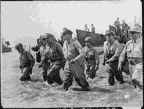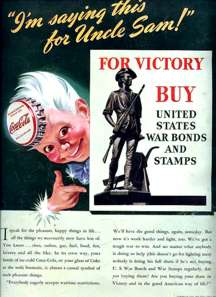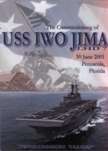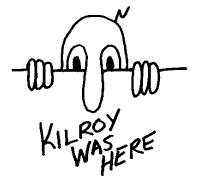
Miscellany—page 2
Gremlins,
Foo Fighters, book reviews, even Lena the Hyena. Here are the sidebars
to history. Interesting, wonderful stories, myths and mysteries. The
best of the books about the war years - then and now.

Kamikaze!
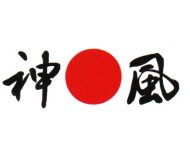
Kamikaze!
Kamikaze pilot's
headband
1n 1570, the Emperor
of China organized a great fleet to invade Japan. Japan was
poorly prepared and expected to be defeated. The gods intervened
by sending a typhoon that destroyed the Chinese fleet. This
became the legend of the "Divine Wind" or Kamikaze.
The later years of
WWII were a desperate time for the Japanese Imperial Navy. The
increasing competence of American aviators coupled with better
equipment and proximity fuses that would explode when near an
enemy aircraft made it almost impossible for Japanese bombers
to get near enough to a ship to bomb it effectively. To solve
this, Japanese Rear Admiral Arima formed a suicide corps named
after this Divine Wind -- the Kamikaze Corps. This suicide corps
had advantages. They could (1) use any aircraft even obsolete
biplanes and Vals (2) they could use poorly trained pilots and
(3) even if hit by AA fire, their momentum would often lead
them on to their target. Kamikaze corps soon used mini subs
and small boats as well.
Soon some
2,500 men were to spend their last terrifying moments as
human bombs; their first determined, accurate attacks took
the lives of more than 7,000 allied servicemen -- and there
were still another 4,500 more being trained. The effectiveness
of these human weapons became a critical factor in the United
States' decision to avoid an invasion of the Japanese mainland
and, instead, drop the atomic bomb. (See
Trinity, The Destroyer of Worlds).
The Results of
the Poll
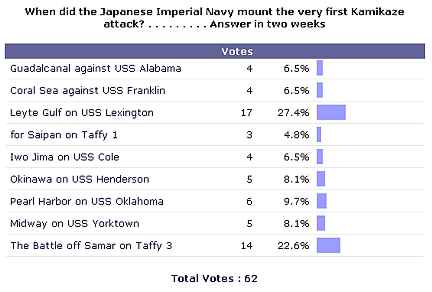
The
answer: This was a tough one. Not many answered but if you selected
either the battle of Leyte Gulf or the Battle off Samar Island,
you are correct! The Battle off Samar island was a part of the
Battle of Leyte Gulf. Which Taffy Escort Carrier squadron was
attacked, however, is in some doubt. In PBS's, Battlefield,
Battle of Leyte Gulf, they said it was Taffy 3. Samuel Eliot
Morison says it was Taffy 1.
The Battle
The Battle of Leyte Gulf
MacArthur originally planned on landing on Mindanao and
using it to support further landings on Leyte and Luzon
but in the softening up, Admiral Halsey reported that defense
was weaker on Leyte than expected. A swift change of plans
brought the Leyte landings on 17-20 October 1944. The defenders
knew by the 10th that the landings were about to start so
they implemented Sho-1, the first of four major plans for
the defense of Japan. The landings were relatively easy
and by midnight 132,400 men and 200,000 tons of supplies
were ashore.
In accordance with
Sho-1, Japanese naval forces sallied forth to turn back the
landings. They came from as far away as the Inland Sea of Japan
and Lingga Roads off Singapore. The battle for Leyte Gulf that
followed included every form of naval engagement including land-based
aircraft from the Philippines, Formosa and Japan. The final
result was that the Japanese Navy was no longer a effective
fighting force.
The Japanese had
carefully planned for this "decisive battle" their
war plans always hoped for. They sent five carriers in a Northern
Force to decoy Halsey's defending Third Fleet - he fell for
it. Their Center force with their two super battleships Musashi
and Yamato (see
Sink the Yamato) would attack through the San Bernardino
Strait. The third or Southern force would attack through the
Surigao Strait. They planned that the Center and Southern forces
would converge on the Leyte Gulf and the unprotected landing
ships and Escort carriers.
The Central Force was
spotted first in the Sibuyan Sea by Halsey's aircraft. By
this time the Japanese land based aircraft had been virtually
destroyed (over 500 losses). Halsey's aircraft attacked
but the pilots exaggerated the damage they actually did.
Because of this and a routine temporary course change by
the Japanese fleet, Halsey assumed that the fleet had retreated.
But the Central Force remained powerful and resumed it's
run to the San Bernardino Strait.
The Northern Force,
meanwhile, had gone undetected. With the last of Japan's carriers
they launched the last Japanese naval air attack of WWII with
only 76 aircraft - none of which did any damage but they succeeded
in luring Halsey away from protecting the landing fleet. Halsey,
believing that the Central Force had been turned back in the
Sibuyan Sea, left his landing ships unprotected and went after
the Northern Force. The Central Force, however, did not turn
back but pushed on through the San Bernardino Straits unopposed!
They, then turned South toward the unprotected landing! There
was nothing between his powerful force and the helpless landing
ships except two escort carrier groups named Taffy 2 and Taffy
3.
Just east of Samar
Island Taffy 3 was the first to engage. When they spotted the
Central Force, they launched all aircraft armed with whatever
was available including depth charges, and ran for it. Taffy
2 and 3 put up a furious fight - so much so that the Japanese
admiral began to think it was a larger force than expected and
that, perhaps, he had stumbled across Halsey's Task Force 38.
Alternatively he had also heard the pleas for help from the
Americans and worried that Halsey would return. By this time,
he was notified that the Southern Force was turned back at the
entrance to Surigao Strait in a classic night surface action.-
he was alone. He turned back missing the opportunity to destroy
the unprotected landings. During this Battle off Samar Island,
Taffy 3 certainly bore the brunt of the Japanese attack but
Taffy 1, almost 130 miles away, has the dubious distinction
of being the recipient of the very first Kamikaze Corps attacks.
This attack sunk one carrier and damaged six.
American
Caesar, Douglas MacArthur 1880-1964, William Manchester, Little,
Brown and Company, 1978
Battlefield, Battle of Leyte Gulf, Corporation for Public Broadcasting
History of the Second World War, B. H. Liddell Hart, G. P. Putnam's
Sons, 1970
The
Rising Sun, The Decline and Fall of the Japanese Empire, John
Toland, Random House, 1970
The Two Ocean War, A short History of the United States Navy
in the Second World War, Samuel Eliot Morison Little, Brown
and Company, 1963
Gremlins,
Foo Fighters, book reviews, even Lena the Hyena. Here are the sidebars
to history. Interesting, wonderful stories, myths and mysteries. The
best of the books about the war years - then and now.
![]()
1n 1570, the Emperor of China organized a great fleet to invade Japan. Japan was poorly prepared and expected to be defeated. The gods intervened by sending a typhoon that destroyed the Chinese fleet. This became the legend of the "Divine Wind" or Kamikaze. The later years of
WWII were a desperate time for the Japanese Imperial Navy. The
increasing competence of American aviators coupled with better
equipment and proximity fuses that would explode when near an
enemy aircraft made it almost impossible for Japanese bombers
to get near enough to a ship to bomb it effectively. To solve
this, Japanese Rear Admiral Arima formed a suicide corps named
after this Divine Wind -- the Kamikaze Corps. This suicide corps
had advantages. They could (1) use any aircraft even obsolete
biplanes and Vals (2) they could use poorly trained pilots and
(3) even if hit by AA fire, their momentum would often lead
them on to their target. Kamikaze corps soon used mini subs
and small boats as well.
The answer: This was a tough one. Not many answered but if you selected either the battle of Leyte Gulf or the Battle off Samar Island, you are correct! The Battle off Samar island was a part of the Battle of Leyte Gulf. Which Taffy Escort Carrier squadron was attacked, however, is in some doubt. In PBS's, Battlefield, Battle of Leyte Gulf, they said it was Taffy 3. Samuel Eliot Morison says it was Taffy 1.
In accordance with Sho-1, Japanese naval forces sallied forth to turn back the landings. They came from as far away as the Inland Sea of Japan and Lingga Roads off Singapore. The battle for Leyte Gulf that followed included every form of naval engagement including land-based aircraft from the Philippines, Formosa and Japan. The final result was that the Japanese Navy was no longer a effective fighting force. The Japanese had carefully planned for this "decisive battle" their war plans always hoped for. They sent five carriers in a Northern Force to decoy Halsey's defending Third Fleet - he fell for it. Their Center force with their two super battleships Musashi and Yamato (see Sink the Yamato) would attack through the San Bernardino Strait. The third or Southern force would attack through the Surigao Strait. They planned that the Center and Southern forces would converge on the Leyte Gulf and the unprotected landing ships and Escort carriers.
The Northern Force, meanwhile, had gone undetected. With the last of Japan's carriers they launched the last Japanese naval air attack of WWII with only 76 aircraft - none of which did any damage but they succeeded in luring Halsey away from protecting the landing fleet. Halsey, believing that the Central Force had been turned back in the Sibuyan Sea, left his landing ships unprotected and went after the Northern Force. The Central Force, however, did not turn back but pushed on through the San Bernardino Straits unopposed! They, then turned South toward the unprotected landing! There was nothing between his powerful force and the helpless landing ships except two escort carrier groups named Taffy 2 and Taffy 3. Just east of Samar Island Taffy 3 was the first to engage. When they spotted the Central Force, they launched all aircraft armed with whatever was available including depth charges, and ran for it. Taffy 2 and 3 put up a furious fight - so much so that the Japanese admiral began to think it was a larger force than expected and that, perhaps, he had stumbled across Halsey's Task Force 38. Alternatively he had also heard the pleas for help from the Americans and worried that Halsey would return. By this time, he was notified that the Southern Force was turned back at the entrance to Surigao Strait in a classic night surface action.- he was alone. He turned back missing the opportunity to destroy the unprotected landings. During this Battle off Samar Island, Taffy 3 certainly bore the brunt of the Japanese attack but Taffy 1, almost 130 miles away, has the dubious distinction of being the recipient of the very first Kamikaze Corps attacks. This attack sunk one carrier and damaged six. American
Caesar, Douglas MacArthur 1880-1964, William Manchester, Little,
Brown and Company, 1978 The
Rising Sun, The Decline and Fall of the Japanese Empire, John
Toland, Random House, 1970 |
Elizabeth and Bob Cook wrote
Bob scanned the following ad
that we thought you'll might enjoy. It is on the back of a Life
magazine dated April 5, 1943. I am going to type what is written
on the back as we are worried that you'll can't read it. It
is excellent and timely. We are attaching the ad in full. It
covered the whole back cover.
"I speak for the pleasant, happy things
in life . ..all the things we necessarily now have less of.
You know . . . tires, radios, gas, fuel, food, fun, leisure
and all the like. In its own way, your bottle of ice-cold Coca-Cola,
or your glass of Coke at the soda fountain, is almost a casual
symbol of such pleasant things.
"Everybody eagerly accepts war time
restrictions. We'll have the good things, again, someday. But
now it's work harder and fight, too. We've got a tough war to
win. And no matter what anybody is doing to help (this doesn't
go for fighting men) nobody is doing his full share if he's
not buying U. S. War Bonds and War Stamps regularly. Are you
buying them? Are you buying your share in Victory and in the
good American way of life?"
Marine
veterans from the 3, 4, and 5th Marines were honored guests
Commissioning
Program. Click for larger view
The Commissioning
of the
USS Iwo Jima LHD7
Editor's
note: On June 30, 2001, I was triply honored. First
because of an invitation from an Iwo Jima veteran, Col.
Norm Gertz, (See his contributions to Kilroy below)
I was allowed to sit with the honored guests, veterans
from the 3rd, 4th, and 5th Marine Divisions. These were
the Guys who took Iwo Jima. Second I was with my brother,
a WWII veteran (see his contributions to Kilroy below)
and third, I was able to renew and old friendship with
a hero of Viet Nam. Colonel Bob Pappas (See his contributions
to Kilroy below.)
During
the Ceremony, they first honored the Marines of the 3rd
4th and 5th Divisions. They had them stand while everyone
clapped (11000 strong even though it steadily rained all
morning.) After the speeches, the new skipper set the
watch and told the OD to "Bring the ship alive."
The sailors ran aboard and stood at attention on the rail.
The Marines then strode up from behind and stood every
other one. All the radars started turning and, in a goose
pimple moment, she "came alive." There was a
very low flyover by five Marine helicopters (very low
because the ceiling couldn't have been over 500'.. Then
they shot fireworks from the bow. It was indeed impressive.
Other
c ontibutions from Norm Gertz:
The
Flies of Saipan,
On Tokyo Rose, P-51s
On Iwo Jima, Saipan
Battle Sites, Found!
Corporal Tommy Iradi,
Found!
Robert Hudgins
Other
c ontributions from Joe Tillery:
B-24
Training, On
VD films, USS
Westpoint, Short
Arm Inspections, Search
for Melvin Stokes,
The
Battle
February
1945. ". . . uncommon Valor Was a Common Virtue."*
Iwo Jima
(Sulfur Island in Japanese) was very important to
the US because it was close enough to Japan to allow
fighter escort for bombers and to provide emergency
landing space for crippled B-29s. The island was
declared secure on March16. Only eight square miles
in size, it was fiercely defended by the Japanese
from extensive underground tunnels that were sometimes
four stories deep. 6281 Marines and an estimated
20,000 Japanese lost their lives. This is almost
one third of all the casualties suffered by the
USMC during WWII. It was the USMC's most savage
and costly battle. The battle was so brutal and
the Japanese so tenacious that it was considered
in the decision to drop the Atomic bomb. If they
would fight this hard for Iwo Jima, imagine the
human loss in invading their homeland.
*Adm. Chester
W. Nimitz, Commander of the Pacific Fleet.
Bob Pappas wrote:
The commissioning ofthe Iwo Jima was one of those most
memorable moments in ones life. No, no bombs were falling,
there was no strafing, no mortars, no machine gun fire,
only the cloudy skies and seasonal rain that drizzled
or poured depending on whether or not you were one of
the lucky ones with an umbrella. But rain or shine, the
commissioning of the USS Iwo Jima, the Navy's newest warship
that has power projection capability unmatched, with its
compliment of trained Marines, fits well into the "memorable
moments" category.
If it had not been raining the tears of pride and patriotism
would have been more noticeable, for in the audience that
numbered well over 10,000, were Iwo Jima veterans and
on the platform, seated with the captains of industry,
government, of the Navy and Marine Corps was the real
giant, really, the only one who counted was Jack Lucas,
who at age 17, and who had enlisted in the Corps at 14,
received the Medal of Honor for Extraordinary Heroism
and Valor during the battle for Iwo Jima over 56 years
ago.
Sports figures are too often described by an ignorant
media commentators as "warriors;" they are not
warriors, only metaphors for the real thing; Jack Lucas,
and the thousands of Marines who fought at Iwo Jima are
the real warriors to whom this nation owes a lasting debt
of gratitude and homage.
At the end of the day, when the excitement of the Iwo
Jima commissioning had subsided, Kayty and I walked away
with a red, white and blue feeling and a big lump in our
throats at seeing that great ship come to life. We raise
our prayer to Almighty God that He will keep Captain John
Narwocki and his crew safe from harm as they go in harm's
way to protect the greatest nation that has ever existed
upon the earth, the United States of America. May God
bless her and the fruit of her womb.
Semper Fidelis,
Other contributions by Robert Pappas:
In 2002 A
Special July 4th Message
In 2001 The
Iwo Jima Commissioning
In 2000 A
Kind Letter
In 2000 A
Special July 4th Message
In 2000 A
Tribute to a Great Marine
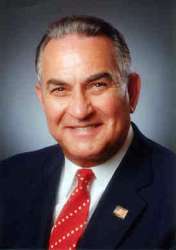
The
Ship
This Iwo
Jima LHD7 is the seventh of the Wasp class amphibious
assault ships. She cost 1.2 billion dollars. Length
844', beam 106', 40,000 ton displacement, speed
22+ knots. She is designed to maintain a smooth
transition from sea to land battle. She carries
assault helicopters, Six to eight Harriers, amphibious
assault vehicles and air cushioned landing craft.
She
is defended by Phalanx close in weapons systems.
They are aimed by radar and put out 2000 20mm rounds
per minute, two eight-cell Sea Sparrow missile launchers
that can fire one round every two seconds, two Rolling
Airframe Missile Systems, four 50-caliber machine
guns, and three 25mm machine guns. She has hospital
facilities second only to hospital ships designed
for that purpose.
The
first Iwo Jima LPH 2 is best known for fishing the
ill-fated Apollo 13 from the sea. She was decommissioned
in 1993.
Eric Shackle
directs his considerable talent toward Kilroy and Chad.
Eric continued his prolific writing career after he retired.
Don't miss his "Life
begins at 80 ... on the Internet." Eric applies
his wit and wisdom to such diverse subjects as British slang
for money and this Kilroy story.
KILROY
AND CHAD WERE EVERYWHERE
By Eric Shackle
If you remember World War II, you will probably recall
seeing graffiti of a funny little man with wide-open eyes
and a huge U-shaped nose, peering over a wall. Britain
knew him fondly as Chad or Mr. Foo, while Americans called
him Kilroy. In Britain, he appeared on walls of buildings,
on shop windows, and in newspaper cartoons. Below him
were the words: WOT
- no sugar? (or Tea, or Cigarettes, or whatever else was
in short supply). In the United States, the caption
just read KILROY WAS HERE. Americans serving in the armed
forces took him
with them wherever they went.
In Britain, he appeared on walls of buildings, on
shop windows, and in newspaper cartoons. Below

Eric
Shackle, then 20, wears the uniform of one of Australia's
few remaining cavalry units at the outbreak of World War
II. Army
commanders soon decided that horses had no role in mechanized
warfare, so the troopers had to swap their horses for
armored vehicles, and their emu-plumed hats for berets
him were the words:
WOT
- no sugar? (or Tea, or Cigarettes, or whatever else was
in short supply). In the United States, the simple caption was
KILROY WAS HERE. Americans serving in the armed forces took
him with them wherever they went. Kilroy was everywhere. "The
outrageousness of the graffito was not so much what it said,
but where it turned up," says trivia master and best-selling
author Charles Panati He cites the torch of the Statue of Liberty,
the Arc de Triomphe in Paris, the Marco Polo Bridge in China,
huts in Polynesia, and a girder on the George Washington Bridge
in New York. There were contests in the Air Force to beat Kilroy
to isolated and uninhabited places around the globe.
Panati says "The
most daring appearance occurred during the meeting of the Big
Three in Potsdam, Germany, in July 1945. Truman, Attlee, and
Stalin had exclusive use of an opulent marble bathroom, off
limits to everyone else. On the second day of the summit, an
excited Stalin emerged from the bathroom sputtering something
in Russian to one of his aides. A translator overheard Stalin
demand, 'Who is Kilroy?'
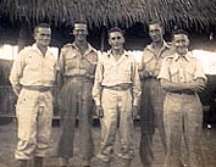
Yanks and Aussies meet as mates at Aitape, New Guinea,
in 1943. From left: John Hershey (U.S.), Norm Terrey (Oz),
Fred ("Nis") Nisley (US), Eric Shackle (Oz)
and Lloyd Thomson (Oz). Where are you now, John and Nis?
Civilians too spread the Kilroy message.
On several occasions, newspapers reported pregnant women
being wheeled into the delivery room, with the hospital
staff finding "Kilroy was here" written across
their stomachs.
In December 1946 the New York Times
credited James J. Kilroy, a welding inspector at the Bethlehem
Steel shipyard in Quincy, Massachusetts, with having given
birth to the craze that swept the world. Usually, it said,
inspectors made a small chalk mark, which welders used
to erase to get paid double for their work. To prevent
this, Kilroy marked work he had inspected and approved
with the phrase "Kilroy was here" in more durable
crayon.
The graffito became a common sight around
the shipyard and was imitated by workers when they were drafted
and sent around the world. As the war progressed, people began
opening void spaces on ships for repair, and the mysterious
Mr. Kilroy's name would be found there, in sealed compartments
"where no one had been before."
Also in 1946, the
Transit Company of America held a contest offering a prize of
a real trolley car to the person who could prove himself to
be the "real" Kilroy. James Kilroy, one of 40 contestants,
took with him officials from the shipyard and some of the riveters
to help prove his case. He won the trolley car, which he gave
it to his nine children as a Christmas gift and set up in their
front yard for a playhouse.
Mr. Foo was the
British services' counterpart of Kilroy. He was also known as
Phoo, Chad, Flywheel, Clem, Private Snoops, and the Jeep. "The
cartoon usually associated with Kilroy... is originally British,
named Mr. Chad, and apparently predates the Kilroy phrase by
a few years," says etymologist Dave Wilton.
"Sometime during the war, Chad
and Kilroy met and in the spirit of Allied unity merged, with
the British drawing appearing over the American phrase. The
OED2 lists Chad's origin as 'obscure,' but it may have been
created by George Edward Chatterton, a cartoonist in civilian
life who spent the war years in the Royal Air Force."
Chris Mullen who
conducts an MA and PhD course on illustration at the University
of Brighton in southern England, quips: "I wondered about
the pregnant Chad in the US elections and thought we were not
being told something wonderful..."
FOOTNOTE: Patrick
A. Tillery has devoted a whole page of his Web site to Kilroy
Legends and Sightings at http://www.kilroywashere.org/(select
Site 1). And there's a long, interesting article about Kilroy
at http://www.straightdope.com/mailbag/mkilroy.html.
That page is described as "the authorized WWW home of legendary
answer-man Cecil Adams, World's Smartest Human, whose syndicated
column has been enlightening readers of the [Chicago] Reader
and other alternative newspapers since 1973. No question too
weird!"
Eric Shackle is a retired journalist who spends much of his
spare time surfing the
Internet and writing about it. His articles have been published
by the New York Times (US), Toronto Globe and Mail (Canada),
Sydney Morning Herald (Australia), and Straits Times (Singapore).

Cobras Over The Tundra
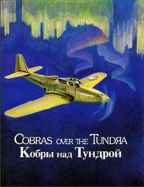 .
by Everett A. Long
.
by Everett A. Long
A
book recommendation by
Senator Ted Stevens (R-AK)
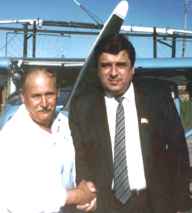
Everett A. Long
and the mayor of Yakutsk, Russia, Pavel Borodin in front of
his Cessna on the Yakutsk airport
Dear Ev:
I continue to marvel at all the work you do for Alaska, to present
our aviation history. That's a marvelous edition "Cobras
Over The Tundra."
You know, I was trained in the AT-9, which made me believe I'd
get Cobras or P-38s. But, as you know the bead pushers then moved
people by lot, instead of by computer, so I flew transports.
Future Alaskans will know the contribution aviation has made to
our state and nation
because of your efforts. Thanks again,
Regards
Ted
(Senator Ted Stevens, Alaska)

Normandy:
The
Search for Sidney
By Thomas
J. Bates/Eric Lummis
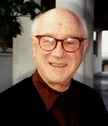
Many of us dream of visiting the sites of great battles of WWII
or Korea. That is, indeed, the reason KilroyWasHere was started.
See the Foreword
(Volume 2). Tom has actually done it and written a gripping,
historic book about his adventure. We have read a lot about
the landings at Omaha (USA 1st Div.), at Utah, (USA 4th Div.),
but little about the landings at Gold (British 50th Div.), Juno
(Canadian 3rd Div.), or Sword (British 4rd Div.) This great
book changes that about Sword in an up close and personal way.
It is really three books. Each could be a
book by itself and well worth the read! The first is Tom's own.
He discovered and was intrigued by Corporal Sidney Bates (same
last name but not related) whose single-handed efforts, firing
a Bren gun from the hip, stopped an attack by panzer grenadiers
after D-day. For this he won The Victoria Cross, ". . .
his sovereign's highest decoration for valour . . . " Tom's
search is for the exact place where Sidney gave his all. Tom,
himself a WWII veteran in Burma, was helped by two Sword survivors
and many French locals who ". . . gladly gave their liberators
the ‘freedom of their fields' in return for the blood their
comrades had spilt there."
An interesting aside is that the book is written
in English and French side by side in two columns per page.
It is done this way as a tribute to a very brave French woman,
Madam Lenauld whose story is told in the second book. Her father
was the gallant French mayor maligned in the Movie "The
Longest Day."
The third book is a detailed battlefield account
of the 1st Battalion, The Suffolk Regiment who, having survived
Dunkirk, landed at Sword.
All three are worthy of being stand alone
books but together, they make an outstanding addition to any
library.
You can order this bookdirectly
from Bates
Books
or from Amazon
or Barnes
and Noble
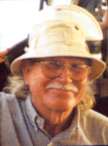
The
Splendid Five
A
True Story about the
Splinter Fleet during WWII
by
Wesley Hall

A splendid story about WWII! Wesley has a
gift for dialog and character building. His book reads like
a novel as he finds himself in a safe backwater trying to get
into the war. His antics are reminiscent of Catch 22 as two
old salts get him into all kinds of trouble which leads to their
being assigned to Splendid Five, a pre-WWI wooden ship shorter
in length than the wingspan of a B-29. It was a subchaser "built
to chase submarines but which could not defend herself from
one."
Splendid Five and her sister ships were assigned
to the Army to support MacArther's island hopping campaign to
the Philippines. It starts in a light-hearted way but rapidly
becomes grim as they enter their first battle off Pelelui*.
The author got his first kill but learned: "Death for us
would never hold the terrors it once had for we had seen it
up close and knew it for what it was: The inevitable calling
in of one's number."
We here at www.kilroywashere.org were delighted
when they spotted a Kilroy Was Here sign on the beach where
" . . . no American could have done that and no Jap would
do it . . . " He never explained how it got there. See
followup from Wesley
in Volume 1, Sightings page 2.
A splendid read indeed. Don't miss it!
*Editor's note:"Bloody
Peleui" cost nearly 2000 American lives and eight thousand
wounded.
To prepare for these
landings at Pelelui, Halsey's TF38 started a softening up campaign.
Four TBFs off the light carrier San Jacinto took off to strike
the radio station at Chichi Jima in the Bonins. A young, unknown
Lt (j.g.) got shot down but was picked up by the American submarine,
Finback. The Lieutenant's name was George H. Bush.
You can order this book at: Amazon
or Barnes
and Noble
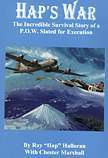
.............................................
Hap's War
By Ray "Hap" Halloran
With Chester Marshall

All right, right up
front, let me say that no veteran of the Pacific War and no one
who was deeply moved by it should miss this book! First, Hap,
the navigator/bombardier, introduces you to the eleven crew members
on his B-29, the Rover Boy, the five that survived the war and
the six who didn't. The theme throughout the book is "completing
the circle."He completes the circle with his crew. He finds
where each is buried and what happened to each that survived.
After that he completes the circle with the Japanese people and
the mission over Tokyo that he didn't finish because he was shot
down. He actually finds one of the "good guards" and
a "good interpreter" that he knew when he was a prisoner.
He finds the actual fighter pilot who shot him down. Two honorable
warriors on opposite sides meeting after the war is always poignant.
Thankfully, he only included the honorable ones. In fact, he says:
". . . I felt at ease being with the families and children
and grandchildren of our former enemy. I do not feel that my feelings
would be the same had some former despicable guards (Horseface,
Watanabe, and several others) appeared in my range of vision."
He also does not succumb to the revisionists who claim we were
wrong to drop the atomic bomb. He quotes an actual document from
the National Archives that proves that the Japanese planned to
kill all prisoners. "Had an invasion (of Japan) taken place,
every Allied POW of the
Japanese would have been killed immediately.
We knew that and sweated out each day. The atomic bomb
drops on Hiroshima and Nagasaki saved our lives."
A great book! Don't miss it.
You can get this book at Hap's own site
http://www.haphalloran.com/
or at Amazon or Barnes and Noble

Brick at B-29 Memorial in Great
Bend, KS. Hap spoke there
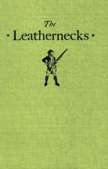
The
Leathernecks
An
informal History of the
US Marine Corps
Selected by Karl
Schuan
Book
supplied by Bob Cook
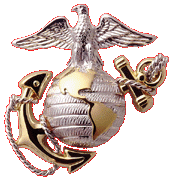
Quizlet
Results: The question was: The USMC is noted for it's amphibious
Landings. Where and when was the first?
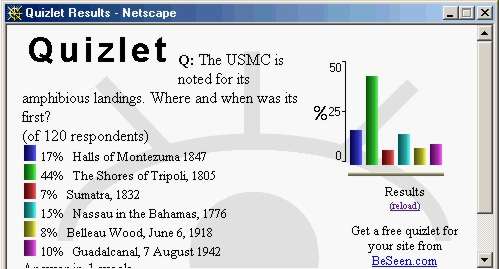
This is
a surprise! Congratulations to those who knew it was in the
Bahamas! As you can see, most of us got it wrong but
more than expected got it right! . The answer is Nassau in the
Bahamas according to The Leathernecks, An Informal History
of the US Marine Corps, selected and edited by Karl Schuon.
This is a book well worth reading! It has readable stories from
the American Revolution to the Cold War. It is out of print
now but readily found at Amazon, Barnes and Noble or Half.com
(see above or below. The details of each of the below stories
are well worth the read.
Nassau in the Bahamas
was #1: The first USMC amphibious landing took place at
New Providence island in the Bahamas in 1776. The British Royal
Navy had large quantities of gunpowder and other war materials
stored there. In the process, they took "Ft. Nassau"
without firing a shot.
The Shores of Tripoli,
1805 (not a landing): "In 1805, a young Marine Lieutenant,
Presley O'Bannon and six enlisted Marines led the most bizarre
army in history across 500 miles of desert sand to attack a
fortress and place a rightful ruler on his throne. In gratitude,
the new potentate presented O'Bannon with a Mameluke sword.
This is the same type sword carried today by Marine officers
— and the oldest weapon in continuous use in the armed
forces of the United States."*
Sumatra, 1832 The
Quallah Battoo corsairs (not a landing): "With the
realization that spice-trading merchantmen could yield wealthy
booty, the natives of Sumatra in 1831 had begun the piratical
practice of rowing out to ships, murdering the officers and
crew and stealing whatever they could carry in their slim canoes.
Finally, word from
an American sea captain prompted the Secretary of the Navy to
take action. The story recounts how the Marines ended, for all
time, the skull-and-crossbones activities of the Quallah Battoo
corsairs."*
From the Halls of
Montezuma 1847 (not a landing): "In the Mexican war,
Marines fought a formidable obstacle on their way to Mexico
City — it was the Citadel of Chapultepec, the West Point
of Mexico since 1773. The cadets called its corridors "The
Halls of Montezuma."*
Belleau Wood, June
6, 1918 (not a Landing): "On this bloody battlefield,
the Germans met their nemesis in man-to-man combat with Marine
bayonets, rifles, pistols and grenades."*
Guadalcanal, 7 August
1942 (1st Marine Corps landing of WWII): "There were
to be many D-days from then on — many H-hours, but it was
the first, the Guadalcanal D-day remains Number One in the memories
of many Marines."*
*The
Leathernecks, An Informal History of the U.S. Marine Corps,
selected and edited by Karl Schuon
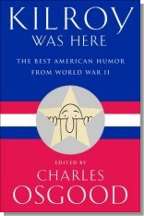
Kilroy Was Here
The Best American
Humor from WWII
Edited by Charles Osgood

Charles Osgood's Kilroy
". . . Dogface infantryman digging
in with battle sounds of shells and grenades exploding around
them and bullets whizzing overhead. The field telephone rings
and a helmeted GI reaches for it, picks it up the receiver and
answers: ‘WORLD WAR TWO.'" Charles Osgood starts his
introduction with this story which, in my mind, typifies the
absolutely amazing GI humor that was a part of WWII!
There are also quotes from entertainers
of that era: "I've learned to say Kaopectate in nine languages
. . . ," Bob Hope; ". . . and it was also how anxious
all of us were to laugh," Ritz Brother, and "If they
have the strength to smile, they smile. It makes a guy proud,"
Humphrey Bogart while visiting a hospital in Naples. Even Banzai
charges and "Dear John letters" were not spared. "Jilted
GIs in India organize the FIRST BRUSH OFF CLUB." Kilroywashere.org
has often taken note of this humor (see links below for a sampling.)
Now, to my delight, so has Charles Osgood (and who could do
it better!) GIs during periods of great stress, that we can
only imagine, managed to find humor wherever they found themselves.
Charles Osgood refers to this directly in the dedication.
All in all, this is my kind of book. It
kept me rocking back and forth between amusement, amazement
and outright thigh slapping. At last, another recognition of
the amazing humor that came out of GIs during that time. Don't
miss this one!
See the publisher's listings for more information:
Hyperion Books
Or order at: Amazon
or Barnes
and Noble
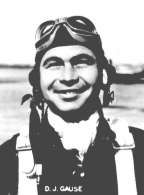
Major
Damon
"Rocky" Gause
War Journal of Major
Damon "Rocky" Gause
By "Rocky" Gause
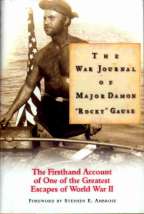 Book
Cover
Book
Cover
Click image for a larger view
Book Review
Written by Charles Martin,
The War Journal of Major Damon "Rocky"
Gause is more than one story. Captain Damon Gause was a
fighter pilot without an airplane, in the Philippines, when
World War II broke out. This is a day to day recounting of Rocky
Gause's remarkable escape from the Japanese at Bataan and Corregidor.
While others were forced into the famous Bataan Death March,
Rocky and a fellow officer chose to take their chances against
the sea and made their way over 3200 miles to Australia in a
small native boat. Hundreds of people risked their lives to
help these two men. Along the way they were given a camera and
a few rolls of film. Rocky kept notes and wrote the whole story
down. Captain Gause got home to see his new son at the hospital
before shipping out to resume fighting the war in Europe. He
never returned. For 50 years his journal was a prized possession
of the family he left behind. Therein lies the second story.
Now his son, Damon Gause of Jefferson, Georgia, has gotten the
story published. He has been invited all over the country to
speak about his father's story. February 27, 2001, Damon Gause
spoke to the Georgia Legislature to tell them of his father's
valor. If Rocky Gause had survived the war he would no doubt
have been a writer -- his one effort was indeed remarkable and
cannot be put down. I would love to see Bruce Willis in the
movie.
Charles A. Martin
Author of "TheLastGreatAce"
These
books are available at . . .

Send Corrections, additions, and input to:
 Back to Miscellany, page 1
Back to Miscellany, page 1
Visitors since
June 6, 2000
|
Elizabeth and Bob Cook wrote "I speak for the pleasant, happy things in life . ..all the things we necessarily now have less of. You know . . . tires, radios, gas, fuel, food, fun, leisure and all the like. In its own way, your bottle of ice-cold Coca-Cola, or your glass of Coke at the soda fountain, is almost a casual symbol of such pleasant things. "Everybody eagerly accepts war time restrictions. We'll have the good things, again, someday. But now it's work harder and fight, too. We've got a tough war to win. And no matter what anybody is doing to help (this doesn't go for fighting men) nobody is doing his full share if he's not buying U. S. War Bonds and War Stamps regularly. Are you buying them? Are you buying your share in Victory and in the good American way of life?" |
|
||||||||||||||
him were the words: WOT - no sugar? (or Tea, or Cigarettes, or whatever else was in short supply). In the United States, the simple caption was KILROY WAS HERE. Americans serving in the armed forces took him with them wherever they went. Kilroy was everywhere. "The outrageousness of the graffito was not so much what it said, but where it turned up," says trivia master and best-selling author Charles Panati He cites the torch of the Statue of Liberty, the Arc de Triomphe in Paris, the Marco Polo Bridge in China, huts in Polynesia, and a girder on the George Washington Bridge in New York. There were contests in the Air Force to beat Kilroy to isolated and uninhabited places around the globe. Panati says "The most daring appearance occurred during the meeting of the Big Three in Potsdam, Germany, in July 1945. Truman, Attlee, and Stalin had exclusive use of an opulent marble bathroom, off limits to everyone else. On the second day of the summit, an excited Stalin emerged from the bathroom sputtering something in Russian to one of his aides. A translator overheard Stalin demand, 'Who is Kilroy?'
The graffito became a common sight around the shipyard and was imitated by workers when they were drafted and sent around the world. As the war progressed, people began opening void spaces on ships for repair, and the mysterious Mr. Kilroy's name would be found there, in sealed compartments "where no one had been before." Also in 1946, the Transit Company of America held a contest offering a prize of a real trolley car to the person who could prove himself to be the "real" Kilroy. James Kilroy, one of 40 contestants, took with him officials from the shipyard and some of the riveters to help prove his case. He won the trolley car, which he gave it to his nine children as a Christmas gift and set up in their front yard for a playhouse. Mr. Foo was the British services' counterpart of Kilroy. He was also known as Phoo, Chad, Flywheel, Clem, Private Snoops, and the Jeep. "The cartoon usually associated with Kilroy... is originally British, named Mr. Chad, and apparently predates the Kilroy phrase by a few years," says etymologist Dave Wilton. "Sometime during the war, Chad and Kilroy met and in the spirit of Allied unity merged, with the British drawing appearing over the American phrase. The OED2 lists Chad's origin as 'obscure,' but it may have been created by George Edward Chatterton, a cartoonist in civilian life who spent the war years in the Royal Air Force." Chris Mullen who conducts an MA and PhD course on illustration at the University of Brighton in southern England, quips: "I wondered about the pregnant Chad in the US elections and thought we were not being told something wonderful..." FOOTNOTE: Patrick
A. Tillery has devoted a whole page of his Web site to Kilroy
|
|
Cobras Over The Tundra A
book recommendation by |
 Everett A. Long and the mayor of Yakutsk, Russia, Pavel Borodin in front of his Cessna on the Yakutsk airport |
| Dear Ev: I continue to marvel at all the work you do for Alaska, to present our aviation history. That's a marvelous edition "Cobras Over The Tundra." You know, I was trained in the AT-9, which made me believe I'd get Cobras or P-38s. But, as you know the bead pushers then moved people by lot, instead of by computer, so I flew transports. Future Alaskans will know the contribution aviation has made to our state and nation because of your efforts. Thanks again, Regards Ted (Senator Ted Stevens, Alaska) |
|
 |
Normandy:The Search for SidneyBy Thomas J. Bates/Eric Lummis |
|
|
It is really three books. Each could be a book by itself and well worth the read! The first is Tom's own. He discovered and was intrigued by Corporal Sidney Bates (same last name but not related) whose single-handed efforts, firing a Bren gun from the hip, stopped an attack by panzer grenadiers after D-day. For this he won The Victoria Cross, ". . . his sovereign's highest decoration for valour . . . " Tom's search is for the exact place where Sidney gave his all. Tom, himself a WWII veteran in Burma, was helped by two Sword survivors and many French locals who ". . . gladly gave their liberators the ‘freedom of their fields' in return for the blood their comrades had spilt there." An interesting aside is that the book is written in English and French side by side in two columns per page. It is done this way as a tribute to a very brave French woman, Madam Lenauld whose story is told in the second book. Her father was the gallant French mayor maligned in the Movie "The Longest Day." The third book is a detailed battlefield account of the 1st Battalion, The Suffolk Regiment who, having survived Dunkirk, landed at Sword. All three are worthy of being stand alone books but together, they make an outstanding addition to any library. You can order this bookdirectly
from Bates
Books |
||
 |
The Splendid FiveA
True Story about the
|
|
|
A splendid story about WWII! Wesley has a gift for dialog and character building. His book reads like a novel as he finds himself in a safe backwater trying to get into the war. His antics are reminiscent of Catch 22 as two old salts get him into all kinds of trouble which leads to their being assigned to Splendid Five, a pre-WWI wooden ship shorter in length than the wingspan of a B-29. It was a subchaser "built to chase submarines but which could not defend herself from one." Splendid Five and her sister ships were assigned to the Army to support MacArther's island hopping campaign to the Philippines. It starts in a light-hearted way but rapidly becomes grim as they enter their first battle off Pelelui*. The author got his first kill but learned: "Death for us would never hold the terrors it once had for we had seen it up close and knew it for what it was: The inevitable calling in of one's number." We here at www.kilroywashere.org were delighted
when they spotted a Kilroy Was Here sign on the beach where
" . . . no American could have done that and no Jap would
do it . . . " He never explained how it got there. See
followup from Wesley
in Volume 1, Sightings page 2. *Editor's note:"Bloody Peleui" cost nearly 2000 American lives and eight thousand wounded. To prepare for these landings at Pelelui, Halsey's TF38 started a softening up campaign. Four TBFs off the light carrier San Jacinto took off to strike the radio station at Chichi Jima in the Bonins. A young, unknown Lt (j.g.) got shot down but was picked up by the American submarine, Finback. The Lieutenant's name was George H. Bush. You can order this book at: Amazon or Barnes and Noble |
||
 |
............................................. By Ray "Hap" Halloran
|
 |
||
All right, right up
front, let me say that no veteran of the Pacific War and no one
who was deeply moved by it should miss this book! First, Hap,
the navigator/bombardier, introduces you to the eleven crew members
on his B-29, the Rover Boy, the five that survived the war and
the six who didn't. The theme throughout the book is "completing
the circle."He completes the circle with his crew. He finds
where each is buried and what happened to each that survived.
After that he completes the circle with the Japanese people and
the mission over Tokyo that he didn't finish because he was shot
down. He actually finds one of the "good guards" and
a "good interpreter" that he knew when he was a prisoner.
He finds the actual fighter pilot who shot him down. Two honorable
warriors on opposite sides meeting after the war is always poignant.
Thankfully, he only included the honorable ones. In fact, he says:
". . . I felt at ease being with the families and children
and grandchildren of our former enemy. I do not feel that my feelings
would be the same had some former despicable guards (Horseface,
Watanabe, and several others) appeared in my range of vision."
He also does not succumb to the revisionists who claim we were
wrong to drop the atomic bomb. He quotes an actual document from
the National Archives that proves that the Japanese planned to
kill all prisoners. "Had an invasion (of Japan) taken place,
every Allied POW of the
|
||||
 |
The
Leathernecks
|
|
|
Quizlet Results: The question was: The USMC is noted for it's amphibious Landings. Where and when was the first? This is a surprise! Congratulations to those who knew it was in the Bahamas! As you can see, most of us got it wrong but more than expected got it right! . The answer is Nassau in the Bahamas according to The Leathernecks, An Informal History of the US Marine Corps, selected and edited by Karl Schuon. This is a book well worth reading! It has readable stories from the American Revolution to the Cold War. It is out of print now but readily found at Amazon, Barnes and Noble or Half.com (see above or below. The details of each of the below stories are well worth the read. Nassau in the Bahamas was #1: The first USMC amphibious landing took place at New Providence island in the Bahamas in 1776. The British Royal Navy had large quantities of gunpowder and other war materials stored there. In the process, they took "Ft. Nassau" without firing a shot. The Shores of Tripoli, 1805 (not a landing): "In 1805, a young Marine Lieutenant, Presley O'Bannon and six enlisted Marines led the most bizarre army in history across 500 miles of desert sand to attack a fortress and place a rightful ruler on his throne. In gratitude, the new potentate presented O'Bannon with a Mameluke sword. This is the same type sword carried today by Marine officers — and the oldest weapon in continuous use in the armed forces of the United States."* Sumatra, 1832 The Quallah Battoo corsairs (not a landing): "With the realization that spice-trading merchantmen could yield wealthy booty, the natives of Sumatra in 1831 had begun the piratical practice of rowing out to ships, murdering the officers and crew and stealing whatever they could carry in their slim canoes. Finally, word from an American sea captain prompted the Secretary of the Navy to take action. The story recounts how the Marines ended, for all time, the skull-and-crossbones activities of the Quallah Battoo corsairs."* From the Halls of Montezuma 1847 (not a landing): "In the Mexican war, Marines fought a formidable obstacle on their way to Mexico City — it was the Citadel of Chapultepec, the West Point of Mexico since 1773. The cadets called its corridors "The Halls of Montezuma."* Belleau Wood, June 6, 1918 (not a Landing): "On this bloody battlefield, the Germans met their nemesis in man-to-man combat with Marine bayonets, rifles, pistols and grenades."* Guadalcanal, 7 August 1942 (1st Marine Corps landing of WWII): "There were to be many D-days from then on — many H-hours, but it was the first, the Guadalcanal D-day remains Number One in the memories of many Marines."* *The
Leathernecks, An Informal History of the U.S. Marine Corps,
|
||
 |
Kilroy Was HereThe Best American Humor from WWII
Edited by Charles Osgood |
Charles Osgood's Kilroy |
|
". . . Dogface infantryman digging in with battle sounds of shells and grenades exploding around them and bullets whizzing overhead. The field telephone rings and a helmeted GI reaches for it, picks it up the receiver and answers: ‘WORLD WAR TWO.'" Charles Osgood starts his introduction with this story which, in my mind, typifies the absolutely amazing GI humor that was a part of WWII! There are also quotes from entertainers of that era: "I've learned to say Kaopectate in nine languages . . . ," Bob Hope; ". . . and it was also how anxious all of us were to laugh," Ritz Brother, and "If they have the strength to smile, they smile. It makes a guy proud," Humphrey Bogart while visiting a hospital in Naples. Even Banzai charges and "Dear John letters" were not spared. "Jilted GIs in India organize the FIRST BRUSH OFF CLUB." Kilroywashere.org has often taken note of this humor (see links below for a sampling.) Now, to my delight, so has Charles Osgood (and who could do it better!) GIs during periods of great stress, that we can only imagine, managed to find humor wherever they found themselves. Charles Osgood refers to this directly in the dedication. All in all, this is my kind of book. It kept me rocking back and forth between amusement, amazement and outright thigh slapping. At last, another recognition of the amazing humor that came out of GIs during that time. Don't miss this one! See the publisher's listings for more information: Hyperion Books Or order at: Amazon or Barnes and Noble |
||
|
Major
Damon |
War Journal of Major Damon "Rocky" Gause
|
 Book
Cover
Book
CoverClick image for a larger view |
|
Book Review The War Journal of Major Damon "Rocky" Gause is more than one story. Captain Damon Gause was a fighter pilot without an airplane, in the Philippines, when World War II broke out. This is a day to day recounting of Rocky Gause's remarkable escape from the Japanese at Bataan and Corregidor. While others were forced into the famous Bataan Death March, Rocky and a fellow officer chose to take their chances against the sea and made their way over 3200 miles to Australia in a small native boat. Hundreds of people risked their lives to help these two men. Along the way they were given a camera and a few rolls of film. Rocky kept notes and wrote the whole story down. Captain Gause got home to see his new son at the hospital before shipping out to resume fighting the war in Europe. He never returned. For 50 years his journal was a prized possession of the family he left behind. Therein lies the second story. Now his son, Damon Gause of Jefferson, Georgia, has gotten the story published. He has been invited all over the country to speak about his father's story. February 27, 2001, Damon Gause spoke to the Georgia Legislature to tell them of his father's valor. If Rocky Gause had survived the war he would no doubt have been a writer -- his one effort was indeed remarkable and cannot be put down. I would love to see Bruce Willis in the movie. Charles A. Martin |
||
|
|
These books are available at . . . |
|
|
|
Send Corrections, additions, and input to:
|
|
|
Visitors since
June 6, 2000 |


